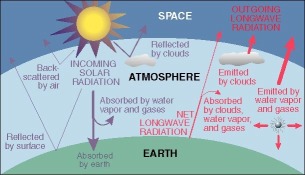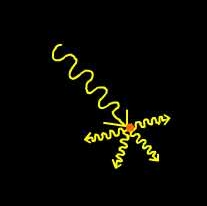4.3.1: The Radiation Balance
- Page ID
- 15861
The radiation balance of the Earth system is an accounting of the incoming and outgoing components of radiation. These components are balanced over long time periods and over the Earth as whole. If they weren't the Earth would be continually cooling or warming. However, over a short period of time, radiant energy is unequally distributed over the Earth.

Shortwave radiation
The radiation balance of the Earth system is depicted in the Figure 4.18. (Shortwave radiation is colored purple and longwave radiation is in red.) Shortwave radiation from the Sun penetrates through space to the outer edge of the atmosphere unimpeded by the vacuum of outer space. Once solar radiation begins to penetrate through the atmosphere this amount begins to decrease due to absorption and reflection.

About 30% of the available solar radiation at the top of the atmosphere is reflected or scattered back to space by particulates and clouds before it reaches the ground. The gases of the atmosphere are relatively poor absorbers of solar radiation, absorbing only about 20% of what is available at the outer edge of the atmosphere. The remaining solar radiation makes its way to surface as direct and diffuse solar radiation. Direct solar radiation (S) is shortwave radiation able to penetrate through the atmosphere without having been affected by constituents of the atmosphere in any way. Diffuse radiation (D) is shortwave radiation that has been scattered by gases in the atmosphere. Scattering is a process whereby a beam of radiation is broken down into many weaker rays redirected in other directions. Together, direct and diffuse shortwave radiation accounts for the total incoming solar radiation or insolation (K↓). In equation form:
K↓ = S+D
A portion of the incoming solar radiation is absorbed by the surface and a portion is also reflected away. The proportion of light reflected from a surface is the albedo (a). Albedo values range from 0 for no reflection to 1 for complete reflection of light striking the surface. Albedo can be expressed as a percentage (albedo multiplied by 100) that for some is easier to understand. For instance, grass has an albedo of about .23. This means that of the incoming solar radiation that strikes the grass, 23% of it is reflected away. On the other hand, highly reflective surfaces like snow have an albedo upwards of .87, or 87% of sunlight is reflected away.
|
Table \(\PageIndex{1}\): Sample Albedos |
|
|
Surface |
Typical Albedo |
|
Fresh asphalt |
0.04 |
|
Worn Asphalt |
0.12 |
|
Bare Soil |
0.17 |
|
Conifer forest |
0.08 |
|
Green Grass |
0.25 |
|
New Concrete |
0.55 |
|
Fresh Snow |
0.80 - 0.90 |
The amount of reflection (K↑) is given by the following equation:
K↑ = (S+D)a
The amount of reflection basically depends on the color of the surface, darker surfaces reflect less than lighter colored ones. For some surfaces, like water, the sun angle affects albedo. If you have been out on a lake during the day you might have noticed that the sun reflects off the surface more when the sun is lower in the sky than it does when it is more directly overhead.

Net shortwave radiation is the difference between incoming and outgoing shortwave radiation expressed as:
K*= (S+D) - (S+D)a
During the day, K* is a positive value as incoming always exceeds outgoing shortwave radiation. At night, K* is equal to zero as the Sun is below the horizon. (No, moonlight doesn't count!)
Longwave radiation
The energy absorbed by the surface is radiated from the Earth as terrestrial longwave radiation (L↑). The amount of energy emitted is primarily dependent on the temperature of the surface. The hotter the surface the more radiant energy it will emit. The gases of the atmosphere are relatively good absorbers of longwave radiation and thus absorb the energy emitted by the surface. The absorbed radiation is emitted in all directions with the downward directed portion being longwave atmospheric counter-radiation (L↓).
The difference between incoming and outgoing longwave radiation is net longwave radiation expressed as:
L* = L↓ - L↑
Recall that under normal conditions air temperature decreases with an increase in altitude through the troposphere. This occurs because the earth is the immediate source of energy for heating the air above it. Knowing that heat is transferred from warmer to cooler bodies, this means the surface is normally hotter than the air above. So for most situations, net longwave radiation is a negative value as more longwave radiation is emitted by the Earth than it gains from the air. Some of this radiation is emitted out to space is lost from the earth system. That which is not lost to space is absorbed by the atmosphere and drives the "greenhouse" effect.
Under other circumstances net longwave can be zero or a positive number. If zero the amount of radiation emitted by the surface would be equal to that of the air. This is true when the air and surface have the same temperature. If the air is warmer than the ground a positive value exists. This could occur with heavy cloud cover (clouds are good absorbers and radiators of longwave radiation) or if a warm air mass travels over a colder surface.
Net Radiation
Net Radiation is the difference between incoming (i.e., S and L↓) and outgoing components of radiation (S+D)a and L↑.
Q*= [(S+D) - (S+D)a] + L↓ - L↑
Net radiation can be positive, negative, or zero. Net radiation is positive when there is more incoming radiation than outgoing radiation. This typically occurs during the day time when the sun is out and the air temperature is the warmest. At night, net radiation is usually a negative value as there is no incoming solar radiation and net longwave is dominated by the outgoing terrestrial longwave flux. Net radiation is zero when the incoming and outgoing components are in perfect balance, which doesn't occur too often.
A net radiometer measures incoming and outgoing radiation from an alpine snow pack. Measurements such as this aid in determining snow melt and the availability of water to fill community reservoirs like those near Boulder, CO.
Understanding net radiation and its distribution is fundamental to explaining many geographical patterns of the components of the earth system. Net radiation is the radiant energy that is available to do work within the earth system. This work is manifested in a variety of ways, from heating the air, to warming the surface, to causing water to evaporate.


